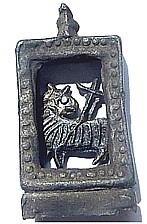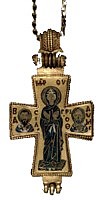
Medieval
Reliquaries
 Personal
reliquaries were pieces of jewellery popular throughout the medieval
period which were often worn as the terminal on a rosary or carried
on the person. Personal
reliquaries were pieces of jewellery popular throughout the medieval
period which were often worn as the terminal on a rosary or carried
on the person.
The defining feature of these items is that they open or are a
vessel of some kind and are designed to hold a relic which is
believed to be holy. This could be a piece of bone from a saint,
a piece of the true cross, a thorn from the crown of thorns or
water or blood from a holy source.
With the interest in pilgrimages
during this period in history, these items could be bought from
sacred sources and stalls along the way. They may or may not have
been actually what they were believed to be. Nevertheless, it
was usual for an ornate receptacle to house this treasure to be
required.
Shown here is the astonishingly
deluxe St Ninian's Reliquary, housed in the British Museum. The
case is filled with pearls of varying sizes making it a valuable
and beautiful piece of jewellery with or without the relic inside.
The relic here is supported to be a sliver of bone from St Ninian's
armbone and small pieces of the skulls of several other saints,
namely Margaret and Boniface.

 Lamb
of God Reliquary case Lamb
of God Reliquary case
Shown at left is a more modest reliquary case with Lamb of God
motif from The Gilbert Collection. It comes from 15th century
Britain. It is made of pewter and measures height 26mm, width
15mm.and weighs a total 3.98 grams.
When new it would have had glass at the front face so that the
holy object placed inside could be seen.
The frame and the lamb are
seperate, intact and in complete condition. Petwer is complete
and intact although the glass is absent. Front frame has singular
raised border and row if raised dots. The Lamb looks backwards
towards the angled cross.

 Gold
Cross Reliquary case Gold
Cross Reliquary case
The Byzantine gold and enamel reliquary cross shown at right is
dated from the 10th century.
It has a hinge at the bottom which opens to reveal the reliquary
inside which is believed to be a piece of the true cross. It has
a suspention loop at the top, although whether this indicates
it was worn around the neck or otherwise attached to another object
like a rosary is not clear.
The case itself measures
just 6cm high, which gives us an idea of the skill of the craftsmen
who did the artwork on the front.

 Circular
Enamel Reliquary case Circular
Enamel Reliquary case
The gold and enamel reliquary pendant shown at the left is dated
at the 13th century. It depicts a military saint with a sword
and has a hinge which opens to hold a relic. Although it is a
small case, it is beautifully decorated and this also contained
a piece of the true cross. At one time, it was owned by St
Kethevan, Queen of Georgia who died in 1624.

Copyright
© Rosalie Gilbert
All text & photographs within this site are the property of
Rosalie Gilbert unless stated.
Art & artifact images remain the property of the owner.
Images and text may not be copied and used without permission.
|